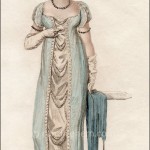Ackermann’s Repository of Arts, July 1810.
This dress is interesting in that it does not have a defined waistline. It is shaped close to the body, but does not have the emphasis on the bosom that a tight high waistline provides. It almost suggests a style a young ingenue would wear rather than a sophisticated lady.
Note the high hemline, much higher than other types of dresses at this time. This shorter length is typically seen in dresses meant for dancing.
The print is described in the magazine as follows:
“A pink gossamer satin slip, with Grecian frock of white Persian gause, or undrest Italian crape; united up the front and round the bottom with silver filigree buttons and chain. The bottom trimmed with a deep vandyke lace, finished at the feet with the same; Spanish slash sleeve, confined with silver filigree buttons and cord. Hair à la Grecque, confined with a pearl comb; the curls parted on the forehead by the introduction of a bunch of Persian roses. Necklace, bracelets, and ear-rings of pearl. Shoes of white satin,spotted with pink foil. Gloves of French kid, below the elbow. Fan of white crape, with Egyptian characters in silver.”








